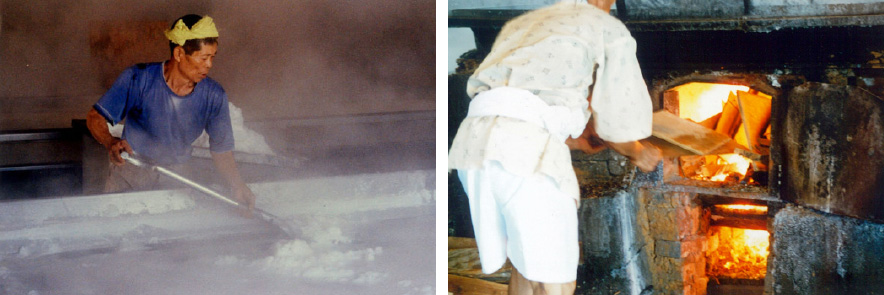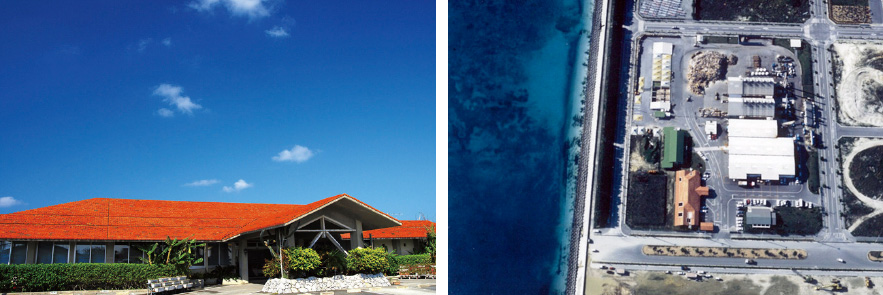Our History
| Apr 1973 | The “Association for the Protection of Okinawa’s Blue Seas and MA-SU (salt)” (referred to as the “Association”) was formed to revive Okinawan salt-making, which was banned due to the Salt Monopoly Law that came into effect after Okinawa was reverted to Japan in 1971. This organization later became the forming body of Aoiumi Co., Ltd. |
| Oct 1973 | Association members establish a business association with the goal of producing Okinawan MA-SU. |
| Feb 1974 | Aoiumi Co., Ltd. is established (registered) as a business in Naha, and a production permit application for “Okinawa’s Salt SHIMAMA-SU” is submitted. |
| Jul 1974 | Japan Monopoly Public Corporation Okinawa Office issues the first permit for plant production of salt in Okinawa. |
| Nov 1974 | The construction of the plant is completed in Takahara, Okinawa City. The headquarters is relocated to the same location. |
| Jan 1975 | Full-scale production begins after test production. |
| Oct 1978 | The headquarters and plant are relocated to Hiyagon, Okinawa City. Plans for expansion outside of the prefecture are in full operation. |
Okinawa is surrounded by the ocean on all sides, and the people of Okinawa have traditionally treasured the salt, or “MA-SU”, created by their salt-making artisans. But after Okinawa was reverted to Japan, the traditional method of salt-making was banned by the Salt Monopoly Law. This wreaked havoc on traditional Okinawan cuisine and prompted the formation of a group with the aim to revive traditional salt-making, which later became Aoiumi Co., Ltd.

As our roots indicate, our goal is to protect and pass on the traditional salt-making methods and the beautiful natural resource that is our oceans. At the time of establishment, we were prohibited from producing MA-SU solely from Okinawan seawater, leading us to obtain the first salt-making permit for production that involved importing bay salt and reprocessing it as the original “Okinawa’s Salt SHIMAMA-SU”.

This method is still continued to today, and involves the dissolution of bay salt (imported from Mexico or Australia) in Okinawan seawater and its recrystallization in open pans. Since our establishment in Takahara, Okinawa City, we have relocated our headquarters and production plant to Hiyagon, Okinawa City, and to the current location at Nishizaki, Itoman City. We have achieved stable production while preserving traditional salt-making methods and constantly adapting to the demands and challenges of the times to maximize efficiency. We will continue to adapt and develop while keeping to the basics of salt-making and our core belief of “providing a safe, reliable supply of products”.
| Feb 1987 | Tokyo office opens in Shibuya district. |
| Oct 1973 | Association members establish a business association with the goal of producing Okinawan MA-SU. |
| Dec 1991 | A new plant with production capacity of 10,000 tons opens in Nishizakicho, Itoman City, Okinawa. Full-scale production begins. |
| Jul 1992 | The headquarters is relocated to the site of the plant in Nishizakicho, Itoman City, Okinawa. |
| Oct 1994 | Establish Sure Natural, Ltd., an affiliated company. (Restructured to an incorporated company in March 2002) |
| Apr 1999 | Osaka Office opens in Toyonaka City. |
In April 1997, the Salt Monopoly Law was repealed, which meant that it was now possible to produce salt directly from seawater. Many sea salt production companies were established in Japan during this time. As the prefecture’s first salt producer, we pioneered the first sea salt from 100% seawater, based on the years of knowledge and technique built up over the course of our history.

The pure salt made from seawater collected 2,000m off the coast of Itoman, Okinawa, is naturally rich with flavors and minerals only found in sea salt. Our salt artisans take the time to slowly boil and concentrate the salt into crystals in open pans. Salt is the basis of all cuisine, no matter what the latest cuisine trends are. We place the utmost importance on quality control, strive to provide safe, natural products, and are always working on developing new items.

| Apr 2003 | Tokyo office is relocated to Shinagawa district. |
| Dec 2005 | Gala Aoiumi, a direct-operation facility, opens in Yomitan Village, Nakagami-gun, Okinawa. |
| May 2006 | Tokyo office is relocated to Shibuya district. |
| Jun 2006 | Kyushu office opens in Fukuoka. |
| Sep 2006 | Obtain the international ISO-9001:2000 (quality control management) accreditation*. Obtain the international ISO-22000:2005 (food safety management system) accreditation*. |
| Mar2008 | Tokyo and Osaka offices are combined. (The Osaka office is closed.) |
| May 2013 | Tokyo office is relocated to Minato district. |
Beginning with sea salt, our products have evolved to meet the needs of our consumers, from bittern, Yakishio (roast salt), and Spice Series, to Magneshio. Production quantity has also increased exponentially. In 2005, a directly operated facility, Gala Aoiumi, was opened to the public in Yomitan Village, Nakagami-gun, Okinawa. It has garnered much attention as the first salt-themed theme park in Okinawa.

We have obtained the international ISO-22000:2005 accreditation*. In recent years, we have expanded our export destinations to Taiwan, Hong Kong, China, South Korea, and other Asian countries, as well as the United States and Europe. We want to spread MA-SU to everyone, domestic and abroad. We will continue to promote well-being through healthy lifestyles and our salt, which is the basic foundation of all cuisine.

International standard ISO-22000:2005
[Food Safety Management System]
- Registration Number:
- JQA-FS0010
- Registered Business:
- Aoiumi Co., Ltd. Headquarters, factories
- Registration Date:
- September 29, 2006
- Registration Renewal Date:
- September 29, 2015
- Registered Activities:
- Salt (including red koji malt salt), bittern product development, production,preservation, and shipping
- Registering Organization:
- Japan Quality Assurance Organization (JQA)

















